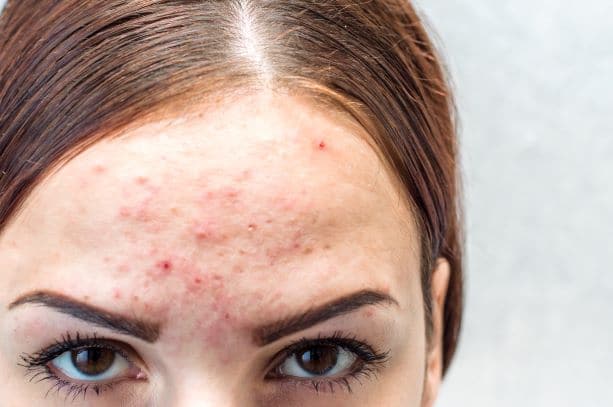Not all breakouts created equal. A specific skin condition commonly called “Fungal Acne” by patients is actually not acne at all. It is known by dermatologists as folliculitis. This condition is sometimes misdiagnosed as acne vulgaris (traditional acne), however. Because the source of these conditions differs, patients who are misdiagnosed can become very frustrated. Even after years of following the treatment regimen for acne vulgaris provided by their dermatologist, patients with folliculitis will likely see little to no improvement. If this sounds like you, you may be dealing with folliculitis, which requires a different treatment plan. But, when properly addressed, you can achieve clear skin and prevent future breakouts. In this blog, we define what folliculitis is and how it can be properly treated to help patients renew their healthy skin and their confidence.
What is “Fungal Acne?”
You may hear this condition referred to by dermatologists as either Malassezia Folliculitis or Pityrosporum Folliculitis. These are all names for the same condition that develops due to an overproduction of Malassezia yeast, which can clog your hair follicles (pores). When the fungal growth clogs pores, patients will experience breakouts on the skin, usually in areas of the body that are prone to sweat like the forehead, neck, shoulders, chest, and back.
What Does Folliculitis Look & Feel Like?
While folliculitis may appear similar to acne vulgaris, it is actually easy to tell the conditions apart if you know what to look for. Unlike traditional acne that has comedones (white and blackhead pimples), folliculitis breakouts usually produce spots (pustules) that are small, red, and very itchy. The most common area for folliculitis breakouts is the upper trunk (back, chest, shoulders), but breakouts can occur on any part of the body.
What Causes Folliculitis?
The cause of folliculitis is an overproduction of the Malassezia yeast. This fungus is naturally occurring on the skin, and it is also responsible for other common skin conditions like dandruff. When Malassezia yeast is produced in higher-than-necessary amounts, it can clog the hair follicles, leading to a breakout that is similar in appearance to acne. In most cases, removing the excess yeast with antifungal medication and keeping skin clean and dry will relieve the outbreak and restore the skin to full health.
How Do Dermatologists Diagnose Folliculitis?
Folliculitis, while very common, is actually frequently undiagnosed or misdiagnosed. Unfortunately, this condition is often mistaken for acne vulgaris, but when patients follow treatment plans for traditional acne, they can actually exacerbate the symptoms of folliculitis. Many patients visit us who have struggled to treat traditional acne, but they have seen little to no improvement after months or even years of consistent treatment for acne vulgaris. When this occurs, it is almost always a misdiagnosed case of folliculitis. To determine whether or not you are dealing with folliculitis, we will take a sample of your skin cells to be examined microscopically. If we determine that the diagnosis is folliculitis, we have patients adjust their skincare plan to address the condition. If the adjusted treatment plan doesn’t clear up the condition, we may perform more in-depth tests to check for immune suppression and other concerns that can make folliculitis harder to treat.
What Treatment Options Are Available?
There are many prescription and over the counter treatments available that help to improve folliculitis symptoms, and many patients actually see dramatic improvement simply by treating the affected area with antifungal dandruff shampoos. This is also a good option if the patient is resistant or has an adverse response to other oral or topical antifungal treatments. In case of a severe or widespread breakout, your dermatologist will almost always prescribe an oral antifungal medication like itraconazole or fluconazole to get rid of fungus and jump-start healing. If you follow your dermatologist’s instructions to care for your fungal acne, you should start to see dramatic improvement within a few days. In most cases, your symptoms should be completely resolved within a few weeks.
Can I Prevent Folliculitis Breakouts?
Unfortunately, some people are just more prone to these types of breakouts, and despite your best efforts, you will not likely be able to completely prevent folliculitis breakouts from happening. However, knowing your body, avoiding potential triggers, and addressing outbreaks right away, can help you keep your skin healthy. Some common triggers that lead to Pityrosporum Folliculitis flareups include:
- Taking antibiotic medications
- Taking steroid medications
- Increased sebum (oil) production
- Excessive or prolonged sweating
- Suppressed immune system
- Blocked hair follicles caused by the use of sunscreen and other products
Malassezia yeast is more likely to grow in warm, damp environments. If you are prone to folliculitis breakouts, you should take special care to shower right away after exercising, enjoying a hot tub, or relaxing in the sauna. You can help to stave off a breakout by using antifungal shampoo or soap at least once a week. As soon as you notice a more serious flareup, schedule a visit with your dermatologist right away. The sooner we begin treating a folliculitis breakout, the sooner your skin health will improve. You should also visit a dermatologist at least once each year for a thorough skin exam and evaluation.
When do I Need to Visit U.S. Dermatology Partners for Folliculitis Treatment?
Whether you’re struggling with acne that doesn’t respond to treatment or you’ve been previously diagnosed with folliculitis and are experiencing a severe breakout, U.S. Dermatology Partners can help you to restore your skin’s health and appearance. We also offer a variety of other dermatology solutions, so please don’t hesitate to contact us for all of your skincare needs. With numerous locations nationwide, there is likely to be a U.S. Dermatology Partners practice near your home. Using our simple online form, you can request a visit with one of our knowledgeable dermatologists to discuss your options to achieve, maintain, or create your best looking and healthiest skin.
Find a location near me
or

